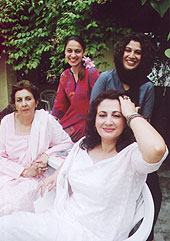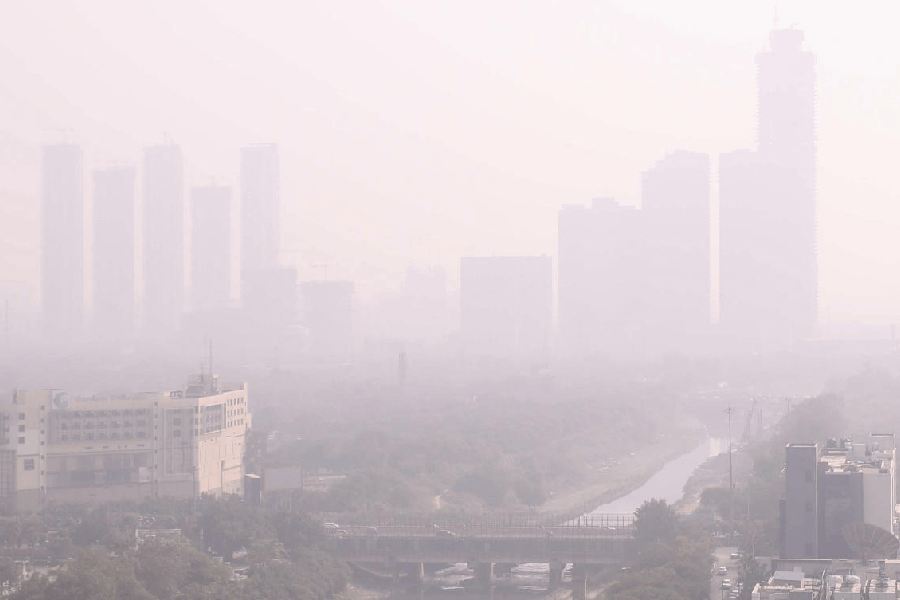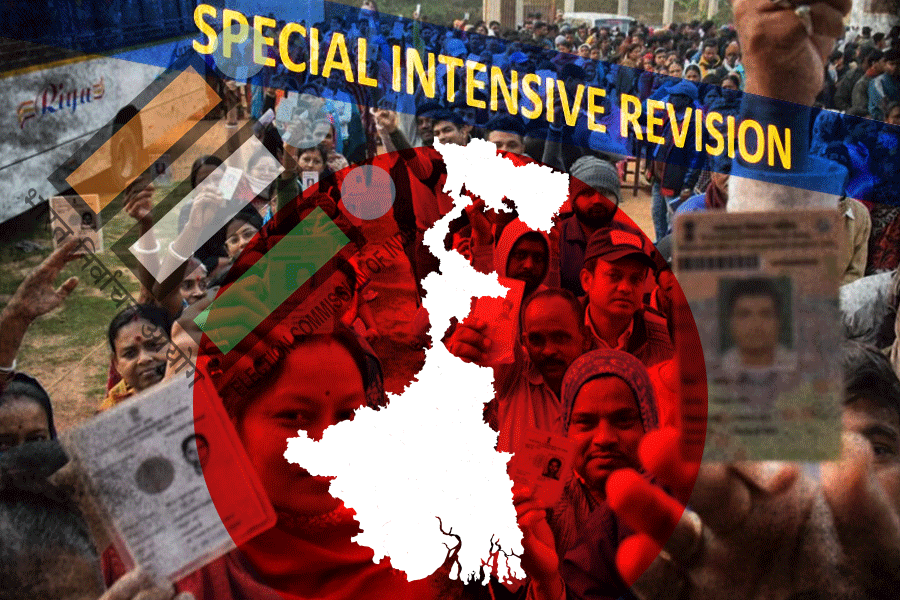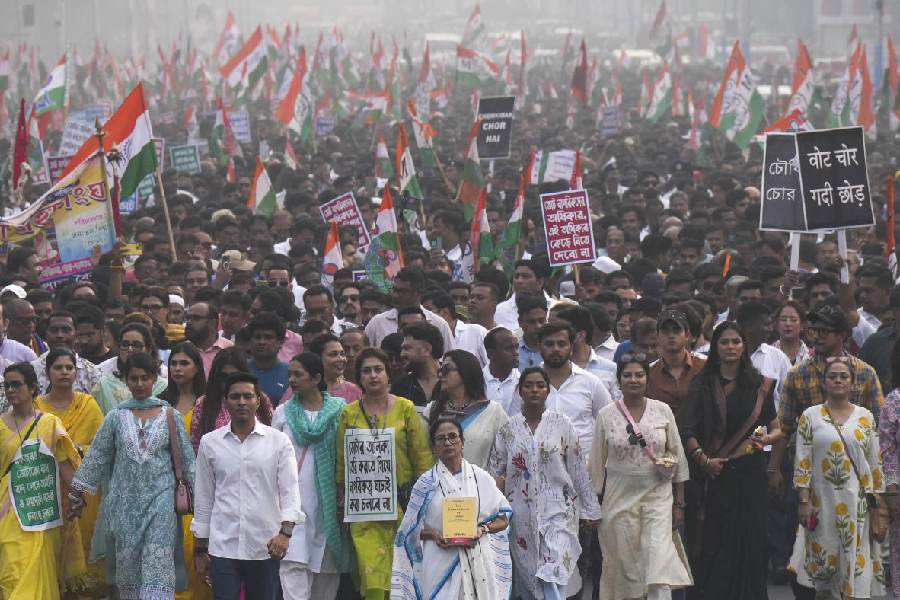 |
| cap BOLD ideas: (Clockwise from top left) Humera Afridi, Sabyn Javeri-Jillani, Feryal Ali Gauhar and Muneeza Shamsie Photo: Rajesh Kumar |
Let’s listen to the story of young Fatu, one of Aai’s seven children. “What cruel tricks fate plays: a female child and mentally handicapped! Fatimah was a beauty, growing up so fast the hand-me-downs from the landlord’s house could hardly keep up with her filled-out curves.” When she is 14, she begins to menstruate. One day, she is pregnant, and no one knows who has done it. The pregnancy is aborted. And then, after a year has passed, she is pregnant again. It’s too late for an abortion.
The narrator ? a writer ? is helpless. The village women pray. And then... Fatu’s story ricochets around the dimly-lit room of a guest house in South Delhi, giving way to the tale of Razia, the ayah. The elder daughter of the family thinks she is too old to have an ayah. “She did not, no would not, would not ever say, and why do I need a cook now? Razia knew this and the cook knew it, too ? so why did the daughter have to say it when he was listening?”
There are several women in the room. Four of them are Pakistani women writers. The fifth is an Indian publisher of women’s writings. The room is redolent with stories. These are tales where protagonists look for roots, find identities, question patriarchy and fine-tune struggles. In one corner of the room ? atop a table ? lies the book that has sparked the discussion. Published by Women Unlimited, And the World Changed: Contemporary Stories by Pakistani women has been edited by Muneeza Shamsie, a writer based in Karachi. The book has as its cover a painting, by Pakistani artist Bashir Mirza, called the Girl with Mirror.
The book is itself a mirror. The 25 stories and extracts are reflections of women on a wide spectrum of issues. Muneeza Shamsie writes about Uncle Jim and the impact he had on his two young nieces growing up in England and Pakistan. Sabyn Javeri-Jillani writes about Bobby Uncle and his new car that witnesses changing times in a once peaceful Karachi mohalla. Humera Afridi looks at an Asian Muslim woman’s visit to a mosque in New York post 9/11. And Feryal Ali Gauhar’s extract from her 2002 book The Scent of Wet Earth in August captures emotions unleashed on a little lane. “These are very, very different subject matters that the writers deal with,” says Muneeza Shamsie. “But there is a curious search in every tale: search for the self, for justice, for the being, for nationality,” she says.
Shamsie is in Delhi for the launch of the book. Sitting with her are three other Pakistani authors whose works have been included in the anthology. Javeri-Jillani is now based in London and focusing on an old love, fiction. Ali Gauhar is a filmmaker who writes and teaches film at the National College of Art, Lahore. And Afridi is a New York Times fellow at the New York University where she is studying creative writing. And with them is Ritu Menon, one of the founders of Kali for Women and now the head of Women Unlimited.
The book happened because of an international conference in Islamabad in December 2002. Menon was there, as was Shamsie. “And one day during the conference, Ritu asked me: ‘Would you like to do this book for me?’” Shamsie recalls. Menon adds that she had been thinking about bringing out a book with the works of women writers of Pakistan. “And it just happened,” she says.
The book underscores a development that has even a veteran publisher like Menon puzzled: Pakistan has a veritable army of women writers in English. The compilation carries the works of a host of writers ranging from Fahmida Riaz, Bapsi Sidhwa, Shahrukh Husain and Hima Riaz to Kamila Shamsie, Sheba Sarwar, Roshni Rustomji and Sara Suleri Goodyear, to name just a few.
Shamsie points out that Pakistan has had a tradition of creative writing in English by women, and holds that The Heart Divided by Mumtaz Shahnawaz, who died at the age of 36 in an aircrash in 1948, was possibly the first south Asian English novel about the Partition.
There were several other writers of note in the early years. Zaib-un-Nissa Hamidullah (1918-2000) was a writer of fiction and Pakistan’s first woman columnist. In the 1950s and 60s, women wrote in English for magazines such as Women’s World brought out by Mujib-un-Nissa Akram, and She, run by Zuhra Karim. Then came Bapsi Sidhwa, who published her much-acclaimed novel, The Crow Eaters, in 1979. A new generation of women authors followed ? some based in Pakistan, and quite a few who lived abroad.
Writing is an individual endeavour, even though women, traditionally, have been encouraged or allowed to communicate through verse,” says Ali Gauhar. “But women’s writing in Pakistan has to be seen in the context of women working within certain confinements and constraints,” says Ali Gauhar, who has just completed a novel ? No Place for Further Burials ? on Afghanistan.
The themes in the anthology are strong ? ranging from a daughter’s fabulous search for justice for her wronged father to a never-say-die mother-in-law who, despite her son-in-law’s best efforts, lives to see another day. Gender runs as a fine thread through several of the stories, but is not an overriding theme. “I am a feminist,” explains Humera Afridi. “But when I sit down and write, I don’t consciously write as a woman,” she says.
Despite the contentious issues that the authors often raise, women’s writings in English seldom kick up a storm in Pakistan. And that is because, the authors say, there is a tendency to dismiss women writers who express themselves in English as unimportant. “The writings are just not considered significant enough,” says Feryal. “It is easier to shrug it off as a product of the decadent west,” adds Shamsie.
There is also a larger reluctance to describe the genre of literature as women’s writings. “I often hear people say: ‘In the old days, we didn’t have women writers and men writers. Ismat (Chugtai) was just a writer. But now, women have claimed her,” says Shamsie. But, clearly, there is no ‘one’ genre of women’s writings in Pakistan. Menon points out that the writings highlight generational differences as well as locational variances. “Where you are is an intrinsic part of how you write,” says Menon.
It’s a belief that Javeri-Jillani endorses, “When I moved to London five years ago, I went through a search for identity for a sense of reality. And so I started writing about my city,” she says.
For writing, Feryal reasons, is one of the few avenues for expression that women have access to. “Men have other ways of expressing themselves. They can play polo, they can whistle on the roads, they can go on a date, they can speak,” she says. “For women, expression is a private process.”
For the writers, though, the expression is often a shared concern as well. “The book is full of little things. This is what makes a woman’s life what it is,” says Shamsie.
Like Fatu’s young life brought to peace by the village women. Together, they chalk out a solution so that Fatu can live, for the time being, at least.










